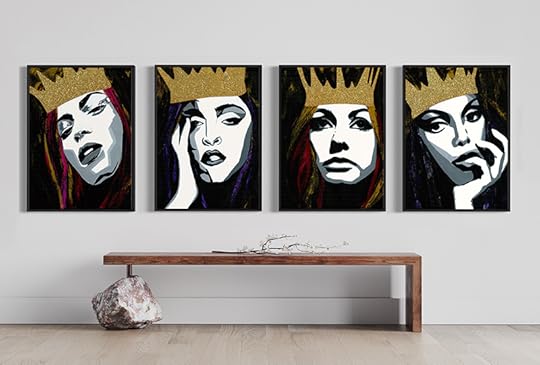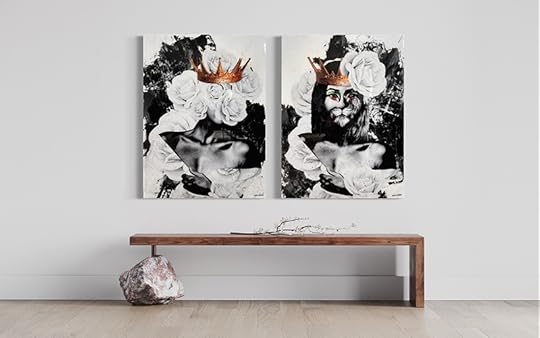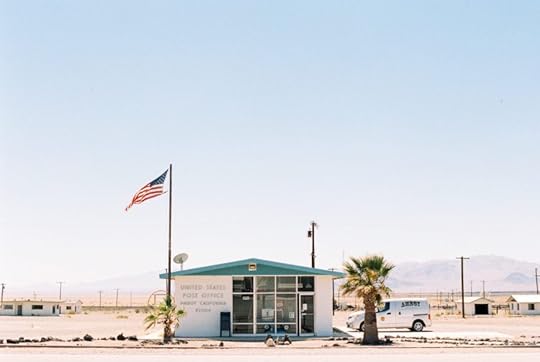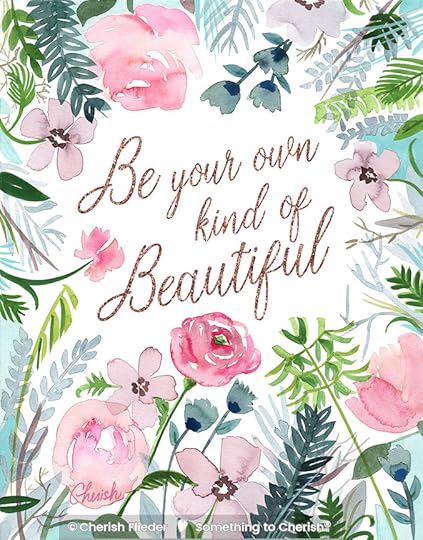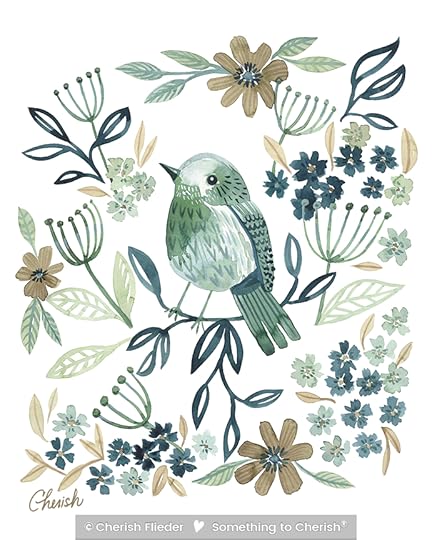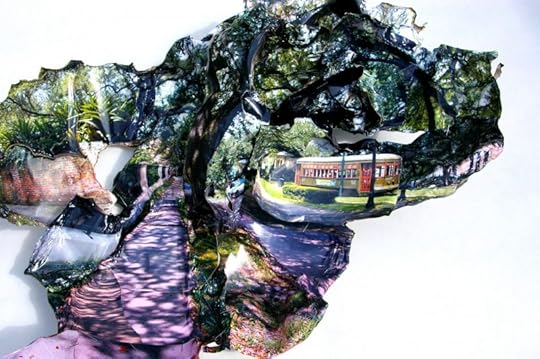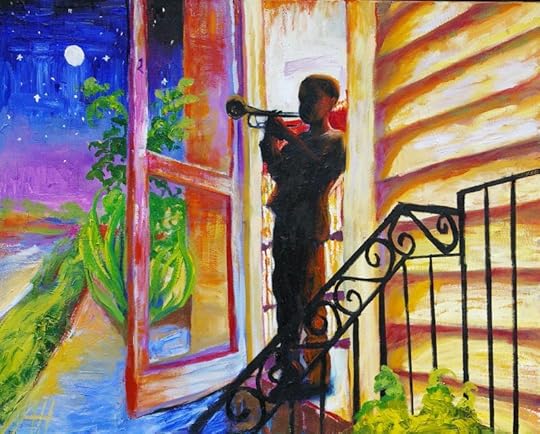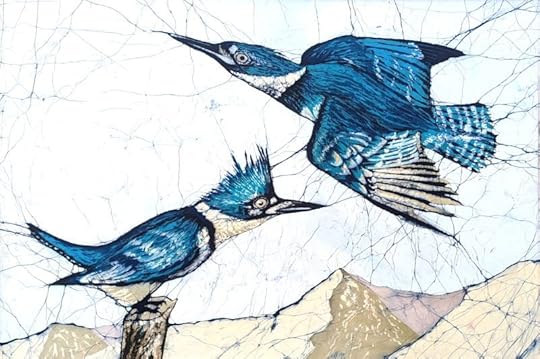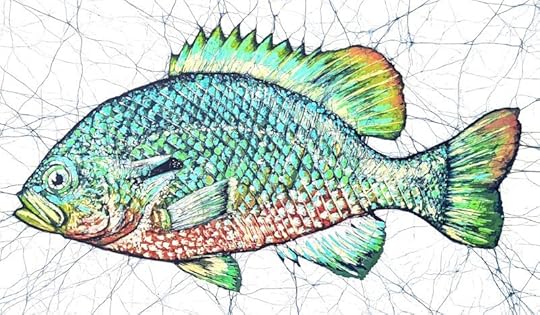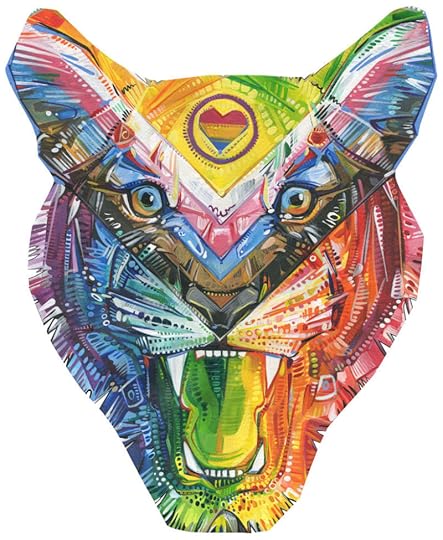Cory Huff's Blog: The Abundant Artist Goodreads blog, page 2
August 24, 2023
How Music Shapes Art for Kathy Lajvardi | TAA Podcast Season 5, Episode 24
Welcome to season five, episode 24 of The Abundant Artist, the show that dispels the myth of “the starving artist” and shares how you can live an abundant life as an artist and make a living from your talent one interview at a time.
Today’s guest is Kathy Lajvardi, a contemporary mixed media artist based in Laguna Beach, California. Kathy was born in Iran and later migrated to the US when she was nine-years-old – a cultural shift that has shaped her as an artist, designer, author and curator. Her diverse artistic background ranges from reflective resin to large-scale paintings that tell a story, are conceptual, and raise awareness.
“You just have to constantly promote yourself, and not wait for someone else to promote you.” — Kathy Lajvardi
In this episode, Kathy shares her journey as an artist, from earning her BFA to working with high-profile clients such as Madonna, Beyonce, Lexus, Disney, and Apple. She further talks about how the late night brainstorming sessions with her husband have turned into actual successful projects over the years, and offers her perspective on the Iranian art and culture scene pre and post the 1979 revolution, and how that has influenced her art.
Join us in this podcast to learn more about Kathy’s art journey, and why she thinks artists should go all out to promote their art themselves rather than waiting to get “discovered”.
In this episode:
[0:35] Cory welcomes Kathy to the TAA podcast and asks her to introduce herself to the TAA audience.
[1:20] Kathy talks about how she went on from earning her art degree to working on motion graphics projects for celebrity musicians, movies and companies like Apple.
[4:35] She transitioned into digital experience post her marriage and the birth of her children, and started managing the Graphics department in her husband’s advertising agency.
[6:25] How Kathy and her husband started organizing wine events with winemakers.
[6:38] What was the Somxx event and how did it happen?
[9:22] Cory asks Kathy about her connection with Iran.
[10:57] Kathy explains the connection between her art and the music she likes to listen to, and why she always works with her headphones on.
[13:52] Kathy further talks about her background, and how her choice of music was received by her family.
[17:50] Cory asks Kathy to describe her series titled “Unbreakable Queens”.
[18:52] Kathy further talks about the Iranian singer Googoosh and her struggles, and how that has inspired the artist’s “Unbreakable Queens” series.
[22:05] Kathy offers her thoughts on what Iran used to be like before the 1979 revolution.
[23:17] Kathy explains in detail how she and her husband organize the events, from visualizing to planning the details to getting sponsors.
[30:35] Kathy deep dives into how once she knows what she wants, she plans the steps needed to achieve that.
[32:17] Why the “hustle mentality” is important, and how social media can be used as a platform to reach a wider audience.
[32:44] Kathy takes her marketing flyers everywhere she goes.
[33:29] Art dealers can surely accelerate an artist’s career, but Kathy insists that an artist can be their own art dealer too.
[34:21] Cory asks Kathy how her events/parties convert into sales.
[37:15] Cory thanks Kathy for joining the podcast!
Resources mentioned:
Kathy Lajvardi’s website
Sommx event
Drive Through Napa
Drive Through Paso Robles
Unbreakable Queens series by Kathy Lajvardi
About the guest:
 Kathy Lajvardi is a contemporary mixed media artist based in Laguna Beach, California. Her artistic background ranges from reflective resin to large-scale paintings that tell a story, are conceptual, and raise awareness. After earning a BFA from Otis College of Art and Design in Los Angeles, Kathy pursued a professional career in advertising film and entertainment. Over the past two decades she has received more than 20 awards for design and art direction. Her art has been featured in Iron Man and Transformers movies. Kathy has also illustrated wine books, designed interiors, and curated events.
Kathy Lajvardi is a contemporary mixed media artist based in Laguna Beach, California. Her artistic background ranges from reflective resin to large-scale paintings that tell a story, are conceptual, and raise awareness. After earning a BFA from Otis College of Art and Design in Los Angeles, Kathy pursued a professional career in advertising film and entertainment. Over the past two decades she has received more than 20 awards for design and art direction. Her art has been featured in Iron Man and Transformers movies. Kathy has also illustrated wine books, designed interiors, and curated events.
The post How Music Shapes Art for Kathy Lajvardi | TAA Podcast Season 5, Episode 24 appeared first on How to Sell Art Online | Online Marketing for Artists.
July 27, 2023
How to Break the Cycle of Always Chasing the Next Sale
So many artists are living paycheck-to-paycheck in the most extreme sense. Sometimes it means they are never getting to go all-in, full-time in the first place. For a long time, this type of starving artist archetype was prolific.
Thankfully, over the last few years, a growing number of artists and authors have started to poke holes in this type of thinking, and we’ve begun to shift our collective mindset.
But while there are lots of conversations about how to aim higher than the starving artist status, there is comparatively little about how to actually achieve this in the real world.
Past the long shot of being discovered, how do you actually break the cycle?
Going from Just-Getting-By to an Established ProfessionalFor starters, it’s a tricky transition going from someone just getting by to an established professional. Some people never manage to make the transition at all.
If you still want to be doing your work years from now and you’re tired of always feeling like you’re hustling for the next client or the next commission just to stay afloat, then this is for you.
Before we dive into the how-tos, I think it pays to understand a little about how and why people get stuck in the first place.
There are a couple common snags that keep good artists stuck. The first is the myth of the muse. If you think that inspiration has to be present before you can do your work, you’re not a professional yet.
Don’t get me wrong. Having ideas is good. But what matters is sitting down and doing the work. Check out The Practice by Seth Godin for more on this.
Another common reason people get stuck is fear.
Fear might be masquerading as excuses, or stalling, or second-guessing. It makes us do crazy things, preventing us from thinking clearly. Fear makes it seem like scrambling for what’s right in front of you is the only option.
Shift Your Horizon LineThe good news is that you don’t have to get your fear under control before you start.
Just make a habit of shifting your horizon line further out in front of you. It’s more than this week and this month. Where do you want to be a year from now? Three years from now?
Now backtrack your steps. If you want to be there in a year, what do you need to be doing six months from now? A month from now? This week? And then do that thing.
If you aren’t in the habit of thinking this way, maybe you start by setting annual goals and revisiting them once every three months. This is a transformative practice. Professional growth starts with personal growth.
Build a CommunityNow that we’ve covered some common reasons why we get stuck, we can turn our attention to what frees us from the hustle.
There are lots of tools we can use (and we’ll talk about those later in this blog), but it all comes down to one thing. Building a community.
If you can build a passionate community of fans, of people who support you and share your work, and are excited to see what you do next, that’s when you enter an entirely new phase. This is what frees you from always chasing the immediate.
Building a community involves doing things today that may not yield results for a long time, years in some cases. It truly is a long game. You’re laying the foundation for clients, commissions and work that’s coming down the road. You do that by connecting with people and building relationships.
To effectively build a passionate community you need two things: consistency and personality.
Learn to Be ConsistentLet’s start with consistency.
Consistency is not the same as frequency. There is a lot of advice that tells you to do more. Post more often. Post on more platforms.
In my experience, this leads to overwhelm and adds to that always-behind feeling. More often than not, the quality of content you’re putting out suffers because of it. You’re putting out a lot, sure, but it’s not very good.
Volume is a good strategy for larger operations, when you have a team and dollars to devote to it. But when you’re small or when it’s just you, trying to keep up is a recipe for failure and burnout.
So, instead of trying to play their game, play to your strengths. Learn to lean into what makes you different.
When you choose platforms and content that you like to do and are able to do, this sets you up to be consistent. For example, don’t start a YouTube channel if you hate being on camera. No matter how profitable someone says it will be.
Next, set a schedule – not an overly ambitious one – and stick to it. Do less, but do it better. Let go of things that are dragging you down. Be brutally realistic with yourself.
What is a schedule you can stick to for years?
Let Your Personality ShineThe next question is what do you post? How do you connect with people? What do you say?
This brings us to the second half of community-building: personality.
When artists are holding back from putting themselves out there, from building an audience, from marketing their work, it’s almost always because they dread feeling salesy.
But that’s why personality is the secret sauce. It transforms something sleazy into something genuine. It’s about inviting people into your story, not tricking them into buying something.
And I get it, when you’re the one doing everything – making the art and doing the marketing, social media, billing, and bookkeeping – it’s understandable that you’re looking for less important pieces to offload.
But this outreach piece, this community building, is not something you want to offload. The best thing you bring to the table is your personality. Your interests, your quirks, your unique point of view. These are the things that are going to help you stand out in a noisy, crowded marketplace.
Lukewarm content is going to get lost. No one cares about your work like you do, understands it like you do. It’s highly likely that your nuance and care get lost when someone else is churning out content for you.
Another way to inadvertently zap out the personality is by copying what’s already out there.
The goal is to create a joyful little corner of the internet for you and people like you. If it already exists, why would they come to you?
So look for inspiration from what others are doing, but avoid blatant imitation. It’s a blueprint, not a checklist.
The magic happens when you take an idea and make it yours.
You’re More Interesting than You ThinkLearn to see what you’re doing with fresh eyes. Turn to the people in your life and the followers you already have for insight too.
Your process may be banal to you, but it’s often interesting to others. Don’t you love getting a glimpse behind the scenes as another artist creates?
So, get outside yourself and see your work – and what you’re posting – from your audience’s point of view. Start by paying attention and taking notes. What creators do you follow? What do you love seeing from them? Who is your favorite person, on any platform, to follow? Why?
Then turn to your own process. How do you find inspiration? Do you read? If so, what books? Where do you go for inspiration? Outside? A Museum? YouTube? Again, what channels? These are all good starting points for finding ways to offer value.
Give your audience something they want to see, and give them a reason to care about what you’re doing. Remember, it’s relationship building. You’re not just consuming from your audience, only reaching out when you want a sale. It’s mutual.
What do people know about the type of art you’re creating? What do they not know?
If you’re in ceramics, show people all the steps from shaping the clay to glazing, firing, and even shipping. If you’re a painter, what kind of paint do you use? How do you choose colors? What happens when you don’t like a painting? How do you prep the canvas? How long does it take to complete a painting?
Always look for ways to be unexpectedly generous. Maybe you pull back the curtain and share time-lapses of your creative process. Or tell people where you buy supplies. Give out some tips and tricks. Help people on their journey and they’ll help you on yours.
Share your struggles (within healthy reason) and your successes.
What do you do to help your mindset? Do you meditate? Have a therapist? What do you do when you feel stuck? What do your days look like? Did you just sell a piece of art or have a new opportunity?
Share your artist’s journey for other artists as well as those who appreciate the work you’re doing.
Where to Connect with Your AudienceHopefully the ideas are flowing now. But where are you sharing them?
Social media is a go-to tool for reaching people. Algorithms can be tricky, but it’s also a free platform for sharing what you’re doing.
If you have a platform you like using, like Instagram, keep using it. If you haven’t already, go check out Charlie Mackesy on Instagram. He’s a great example of being genuine and generous online, plus he also gives you insights into how he creates.
But even when done flawlessly, social media shouldn’t be your whole strategy. These platforms own your audiences, not you. If Instagram would be gone tomorrow, how would you reach your community?
It’s old school, but look to create your own email list.
That way no matter what platforms come and go, you can reach your people. And keep the same concepts in mind. Look for ways to add joy and value to people’s lives. Be genuine.
Let’s say you have a gallery show coming up or new artwork is going to hit your site soon. Use your email list to talk about it – ask for support, even for a sale. A good rule of thumb is to send 3-4 emails to simply connect and add value for every email asking for a sale.
Patreon is another great resource for building a community of patrons in the online world. Again, the same principles apply. Look for ways to add value.
Be generous. Be consistent. Give people behind-the-scenes access to your creative process. Make it a relationship. These are the sorts of things that help you stand out and build the type of online community you can feel good about.
If you’re a filmmaker, consider creating original content for YouTube. If you are a talented writer, publish on your own website. Use that gift to write thoughtful emails too.
In short, find what works for you and commit to it. There is no one right way to build an online community. The goal is to leverage this brainstorming to spark an idea that works for you.
I don’t want to hand you a recipe. I want to show you how to be a chef and then watch what you create. To do anything else would be to destroy the personality and humanity that only you can bring to the table.
Trust the ProcessI hope you feel excited about building your own passionate community. Maybe you even feel encouraged that this hustle culture, always-behind feeling doesn’t have to be forever.
As you start this new chapter, just remember to trust the process.
Do the work in the right way, and the outcome will take care of itself. Building this community is how you break the cycle of chasing the immediate. It’s how you make space (in your head and your schedule) for your best work.
And it’s also how you earn raving fans.
You don’t need a lot of them to thrive. It’s quality over quantity. Genuine over salesy. So use time to your advantage. Start now because there’s no shortcut to years of content and community building.
Your future self thanks you.
About the Guest:
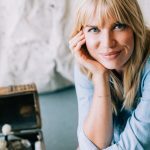 Joella Marie is the founder of Creative Voices. She is an artist by nature who felt the pressure to “get serious” and opted to attend business school. A few years after college, she left marketing to make a career as a fine art film photographer before eventually finding a way to lovingly combine the two. Today, she is devoted to helping art entrepreneurs creatively brand and market their work without feeling sleazy or salesy. And ultimately she believes in the power of meaningful work to help us all feel more engaged in our lives, which is why she created a free mini-class. And yes, she still photographs.
Joella Marie is the founder of Creative Voices. She is an artist by nature who felt the pressure to “get serious” and opted to attend business school. A few years after college, she left marketing to make a career as a fine art film photographer before eventually finding a way to lovingly combine the two. Today, she is devoted to helping art entrepreneurs creatively brand and market their work without feeling sleazy or salesy. And ultimately she believes in the power of meaningful work to help us all feel more engaged in our lives, which is why she created a free mini-class. And yes, she still photographs.
The post How to Break the Cycle of Always Chasing the Next Sale appeared first on How to Sell Art Online | Online Marketing for Artists.
July 13, 2023
Art Licensing Explained with Cherish Flieder | TAA Podcast Season 5, Episode 23
Welcome to season five, episode 23 of The Abundant Artist, the show that dispels the myth of “the starving artist” and shares how you can live an abundant life as an artist and make a living from your talent one interview at a time.
Internationally featured and award-winning artist/designer Cherish Flieder joins TAA founder Cory Huff in today’s podcast. Apart from being a creative entrepreneur, Cherish is also a teacher and the founder of a virtual art licensing community, ArtLicensingShow.com.
“(Art licensing) is a lot of risk, but when you hand your art over to people you trust, they can get it out there in a really big way.” — Cherish Flieder
In this episode, Cherish explains what is art licensing and how it can actually be a viable business model for artists, talks about her first love i.e. children’s book cover illustrations, and reminisces about her journey of art licensing from greetings cards and book cover to fashion apparel and ultimately launching her own art lifestyle brand.
Tune in to listen to Cherish’s journey in art licensing, and what you must know as an artist to potentially adopt this business model.
In this episode:
[:37] Cory introduces Cherish to TAA podcast listeners
[2:20] What is art licensing? Cherish explains how it’s a viable business model for artists
[3:35] Different types of products on which Cherish’s artwork has been shown. How she started with children’s book cover illustrations after art school
[4:30] Why do most artists start with licensing their artwork for greetings cards?
[5:20] How the process of licensing her art to fashion companies ultimately led Cherish to launch her own trademarked art lifestyle brand, Something to Cherish®
[7:37] Cherish describes her artwork as “whimsical elegance”
[9:45] Why Cherish believes in partnering with experts for production and marketing
[10:22] Cory asks Cherish what she thinks has changed in art licensing in the last couple of years
[11:00] How “Fast Fashion” brands are changing trends even on a weekly basis, and what artists need to know while licensing their art to fashion houses
[12:03] Why artists licensing their art must be connected with fellow licensing artists or communities
[14:51] How can artists position their art in the market to make the most of whatever opportunities come their way?
[17:06] Cherish throws some light on what her business planning process looks like
[18:30] The Notion App Cherish uses for the business side of her creative venture
[22:50] How the Clubhouse social audio network has been a useful community for Cherish
[24:35] Why do so few art schools have courses on art marketing?
[30:03] Why only ~50% of artists taking a marketing course implement the learning in their art business
[32:14] What is a more realistic expectation for an artist who’s just getting started selling their art?
[34:53] Why consistency is key while marketing your art
[35:43] Size of your social media follower base may not convert to actual sales. What social media strategies Cherish recommends for driving the sale of artwork
[43:] What steps does Cherish recommend for artists seeking to license their art to what she calls “companies behind companies”?
[45:09] What are Cherish’s favorite trade shows? Why is it important to visit trade shows to understand your chosen niche in the market for licensing your art e.g. gift items or home décor?
[47:07] Cherish advises artists to start researching the market first on their own before handing over their licensing business to agents. And it is important to have a lawyer check your licensing agreements
[47:32] Cory asks Cherish to explain for the audience what an ASMR video is, and why she recently experimented with creating one
[50:25] Cherish talks about her “Gratitude Practice”
[51:48] Cory thanks Cherish for joining the podcast!
Resources mentioned:
Cherish Flieder’s Website
Art Licensing Community founded by Cherish Flieder
About the guest:
 Cherish Flieder is a highly acclaimed artist known for her whimsical watercolor paintings inspired by nature. With her brand Something to Cherish® she creates treasured fashion, stationery, and gift items with idyllic illustrations and uplifting messages, conveying love and self-worth. Cherish’s designs have sold worldwide and can be found in various retail outlets, including galleries, boutiques, department stores, and online marketplaces. With a triple-major BFA in Illustration, Fine Art, and Design, Cherish draws upon her experience in art licensing, marketing, and publishing to mentor creative entrepreneurs. She founded the global Art of Licensing network to empower art licensing professionals.
Cherish Flieder is a highly acclaimed artist known for her whimsical watercolor paintings inspired by nature. With her brand Something to Cherish® she creates treasured fashion, stationery, and gift items with idyllic illustrations and uplifting messages, conveying love and self-worth. Cherish’s designs have sold worldwide and can be found in various retail outlets, including galleries, boutiques, department stores, and online marketplaces. With a triple-major BFA in Illustration, Fine Art, and Design, Cherish draws upon her experience in art licensing, marketing, and publishing to mentor creative entrepreneurs. She founded the global Art of Licensing network to empower art licensing professionals.
The post Art Licensing Explained with Cherish Flieder | TAA Podcast Season 5, Episode 23 appeared first on How to Sell Art Online | Online Marketing for Artists.
June 29, 2023
New Orleans Artist Adam Hall | TAA Podcast Season 5, Episode 22
Welcome to season five, episode 22 of The Abundant Artist, the show that dispels the myth of “the starving artist” and shares how you can live an abundant life as an artist and make a living from your talent one interview at a time.
“My life is designed to sell paintings. If I was not selling that many paintings, I would need to change something.” — Adam Hall
Joining the podcast today is Adam Hall, who describes himself as “an artist who paints New Orleans”. Born in Raleigh, North Carolina, Adam’s tryst with New Orleans started when he joined Tulane University there to obtain an undergraduate degree in studio art and history. Although later Adam studied in the School of the Art Institute of Chicago (BFA) and the Pennsylvania Academy of Fine Arts (MFA), he eventually decided to move back to New Orleans and settle there.
The impact of Hurricane Katrina is visible in Adam’s art, especially in his black-and-white, burnt-paper three-dimensional collages that explored themes of loss and upheaval. A visit to Paris in 2009 and the study of impressionist painters convinced him to switch to impressionist oil paintings.
In this episode, Adam explains why he calls New Orleans his home, his metamorphosis from a sculptor/installation artist to an impressionist painter, how Hurricane Katrina has inspired his artworks, and how he manages the business side of his art career.
In this episode:
[:33] Cory reminisces how he has known Adam since 2013.
[4:05] Why Adam has found his “artistic home” in New Orleans.
[5:45] How Adam’s website captures the fascinating evolution of his artworks.
[7:15] Adam was more into sculptures and installations during grad school. Why has he taken up painting after moving to New Orleans?
[10:05] How has Hurricane Katrina shaped Adam’s artistic expressions?
[12:38] Why it was important for Adam to create artworks that looked similar to oak trees.
[20:12] How over time Adam coached himself to make impressionist paintings of New Orleans.
[32:30] How Adam has designed his life for selling paintings.
[33:40] Adam enjoys the business side of his art career. It’s not “work” for him.
[36:40] How Adam’s New Orleans paintings changed over time and why.
[38:14] How the pandemic impacted Adam’s choice of subjects for paintings.
[41:11] How did Adam figure out what works for him in the business side? How TAA class helped Adam with finding his “voice”.
[46:14] What kind of write-ups Adam does regularly for his collectors. How does he decide on what to write?
[49:07] Social media and his website helped Adam sell his paintings more than outdoor shows.
[51:11] What’s working for Adam on social media?
[53:00] What’s Adam excited about his art business at the moment?
[55:03] Cory thanks Adam for joining the podcast!
Resources mentioned:
Adam Hall’s Website
Adam’s Blogs
About the guest:
 Adam’s paintings are inspired by the vibrancy and distinctive character of New Orleans. His early work (2005-2010) expressed his reaction to Hurricane Katrina through black-and-white, burnt-paper three-dimensional collages that explored themes of loss and upheaval. Adam’s work has been exhibited in New Orleans, Martha’s Vineyard, Woodmere Art Museum in Philadelphia, the University of Alabama, at the Duke University Law School, and at the Governor’s Mansion in Baton Rouge; and featured in the book Papercraft, published by the Gestalten press. His large 12-foot painting titled “Resolve” was installed on the campus of Tulane University’s Flower Hall in 2017, and in the same year he won “Best in Show” at the Red River Revel, a music and arts festival in Shreveport, Louisiana. Adam shows his work at arts markets in New Orleans and from his home studio.
Adam’s paintings are inspired by the vibrancy and distinctive character of New Orleans. His early work (2005-2010) expressed his reaction to Hurricane Katrina through black-and-white, burnt-paper three-dimensional collages that explored themes of loss and upheaval. Adam’s work has been exhibited in New Orleans, Martha’s Vineyard, Woodmere Art Museum in Philadelphia, the University of Alabama, at the Duke University Law School, and at the Governor’s Mansion in Baton Rouge; and featured in the book Papercraft, published by the Gestalten press. His large 12-foot painting titled “Resolve” was installed on the campus of Tulane University’s Flower Hall in 2017, and in the same year he won “Best in Show” at the Red River Revel, a music and arts festival in Shreveport, Louisiana. Adam shows his work at arts markets in New Orleans and from his home studio.
The post New Orleans Artist Adam Hall | TAA Podcast Season 5, Episode 22 appeared first on How to Sell Art Online | Online Marketing for Artists.
June 1, 2023
What does an Art Advisor do with Maria Brito | TAA Podcast Season 5, Episode 21
Welcome to season five, episode 21 of The Abundant Artist, the show that dispels the myth of “the starving artist” and shares how you can live an abundant life as an artist and make a living from your talent one interview at a time.
Our podcast usually features professional artists, but this week’s guest has such a vast experience in the art world, we decided to shake up our usual!
Maria Brito is an Art Advisor, Art Consultant, and Curator. She has spent more than a decade working with a multitude of well-known artists as well as emerging talent, getting them in touch with her clients and building long-term relationships. She also works with corporate clients, helping foster creativity wherever she can.
“My mission was to open up the doors of this obscure, snob world of galleries and auction houses, and give people a gateway to that world.” — Maria Brito
Maria comes on the show to discuss her unique perspective on the art business, and how it intersects with the rest of the world. Cory and Maria discuss the revolutionary changes that technology has enabled, decentralizing the art practice and collectors’ markets. They also touch on what artists need to succeed in the free markets as well as in the official art machinery, and how an increasingly polarized world requires open-mindedness and curiosity to move forward.
Join in for a lively discussion on the ever-evolving business of art making.
In this episode:
[:30] Cory welcomes Maria Brito to the podcast and dives right in with a question about failure.
[1:30] Always remember that failure is impersonal. Maria shares her perspective on the importance of self-reflection and the piecing together of clues to build future projects. She shares a personal story of learning and growth through failure.
[6:50] Maria encourages listeners to take time to review past failures and how they were used to better their practice.
[8:11] What does an art advisor do?
[11:19] From very unhappy corporate attorney to art advisor, consultant, and curator, Maria talks about how her path diverged almost 14 years ago.
[19:22] “Emergent artist” is a term that has changed meaning over time, but belongs to the official machinery of art galleries. Maria speaks about the label “outsider artists,” used for people who evolve away from those official structures.
[24:55] Many cities all over the world are brimming with art ecosystems because technology has enabled a wonderful decentralization of opportunities.
[26:20] How galleries contact Maria, and what they share as information for consideration.
[31:00] A substantial percentage of the art market originates from Instagram, close to $7.5 billion!
[33:25] The three things artists should get good at to build their following on Instagram.
[35:03] Teaching the creative process to corporate clients was years in the making, Maria shares how it came to fruition and some of what she teaches.
[40:00] The starving artist myth needs to be broken. From Picasso to O’Keefe, Maria explains why artists need to stop underestimating themselves as entrepreneurs.
[44:23] Maria’s favorite art and entrepreneurship studies.
[49:00] Pursuing a career for the sake of happiness and creativity versus that of safety has nurtured in Maria a need to share her knowledge to inspire other people to follow their passion.
[53:28] The consistent habits of the creative mind as well as the counter-productive nature of anger and self-righteousness.
[1:08:12] Maria’s advice for aspiring artists in a world that is rife with excellent competition: train your eye and choose your platform.
[1:15:40] Cory thanks Maria for joining the podcast and sharing so much of her knowledge!
Resources mentioned:
Maria Brito’s website
@MariaBrito_NY on Instagram
@MariaBrito_NY on Twitter
Maria on Facebook
Hiscox Online Art Trade Report 2021
Harvard Business School:
“Christo and Jeanne-Claude, The Art of the Entrepreneur”
“Theaster Gates: Artist as Catalyst for Community Development”
“Building an Aspirational High-End Brand through Cultural Engagement: Absolut Vodka’s Love Affair with Art”
The Warhol Economy: How Fashion, Art, and Music Drive New York City, by Elizabeth Currid-Halkett
Paducah Kentucky art scene
About the guest:
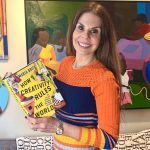 Maria is an award-winning New York-based contemporary art advisor, author, and curator. She’s the author of the bestselling book How Creativity Rules The World (HarperCollins). She has written for publications such as Entrepreneur, Huffington Post, Elle, and Forbes, just to name a few. For several years, Maria has taught her creativity course in companies and, in 2019, she launched “Jumpstart”, an online program on creativity for entrepreneurs based on years of research and observation in both the areas of business and art. She works with a number of celebrities, including Sean Combs, Gwyneth Paltrow and fitness guru Tracy Anderson.
Maria is an award-winning New York-based contemporary art advisor, author, and curator. She’s the author of the bestselling book How Creativity Rules The World (HarperCollins). She has written for publications such as Entrepreneur, Huffington Post, Elle, and Forbes, just to name a few. For several years, Maria has taught her creativity course in companies and, in 2019, she launched “Jumpstart”, an online program on creativity for entrepreneurs based on years of research and observation in both the areas of business and art. She works with a number of celebrities, including Sean Combs, Gwyneth Paltrow and fitness guru Tracy Anderson.
The post What does an Art Advisor do with Maria Brito | TAA Podcast Season 5, Episode 21 appeared first on How to Sell Art Online | Online Marketing for Artists.
What does an Art Advisor do with Maria Brito | TAA PODCAST SEASON 5, EPISODE 21
Welcome to season five, episode 21 of The Abundant Artist, the show that dispels the myth of “the starving artist” and shares how you can live an abundant life as an artist and make a living from your talent one interview at a time.
Our podcast usually features professional artists, but this week’s guest has such a vast experience in the art world, we decided to shake up our usual!
Maria Brito is an Art Advisor, Art Consultant, and Curator. She has spent more than a decade working with a multitude of well-known artists as well as emerging talent, getting them in touch with her clients and building long-term relationships. She also works with corporate clients, helping foster creativity wherever she can.
“My mission was to open up the doors of this obscure, snob world of galleries and auction houses, and give people a gateway to that world.” — Maria Brito
Maria comes on the show to discuss her unique perspective on the art business, and how it intersects with the rest of the world. Cory and Maria discuss the revolutionary changes that technology has enabled, decentralizing the art practice and collectors’ markets. They also touch on what artists need to succeed in the free markets as well as in the official art machinery, and how an increasingly polarized world requires open-mindedness and curiosity to move forward.
Join in for a lively discussion on the ever-evolving business of art making.
In this episode:
[:30] Cory welcomes Maria Brito to the podcast and dives right in with a question about failure.
[1:30] Always remember that failure is impersonal. Maria shares her perspective on the importance of self-reflection and the piecing together of clues to build future projects. She shares a personal story of learning and growth through failure.
[6:50] Maria encourages listeners to take time to review past failures and how they were used to better their practice.
[8:11] What does an art advisor do?
[11:19] From very unhappy corporate attorney to art advisor, consultant, and curator, Maria talks about how her path diverged almost 14 years ago.
[19:22] “Emergent artist” is a term that has changed meaning over time, but belongs to the official machinery of art galleries. Maria speaks about the label “outsider artists,” used for people who evolve away from those official structures.
[24:55] Many cities all over the world are brimming with art ecosystems because technology has enabled a wonderful decentralization of opportunities.
[26:20] How galleries contact Maria, and what they share as information for consideration.
[31:00] A substantial percentage of the art market originates from Instagram, close to $7.5 billion!
[33:25] The three things artists should get good at to build their following on Instagram.
[35:03] Teaching the creative process to corporate clients was years in the making, Maria shares how it came to fruition and some of what she teaches.
[40:00] The starving artist myth needs to be broken. From Picasso to O’Keefe, Maria explains why artists need to stop underestimating themselves as entrepreneurs.
[44:23] Maria’s favorite art and entrepreneurship studies.
[49:00] Pursuing a career for the sake of happiness and creativity versus that of safety has nurtured in Maria a need to share her knowledge to inspire other people to follow their passion.
[53:28] The consistent habits of the creative mind as well as the counter-productive nature of anger and self-righteousness.
[1:08:12] Maria’s advice for aspiring artists in a world that is rife with excellent competition: train your eye and choose your platform.
[1:15:40] Cory thanks Maria for joining the podcast and sharing so much of her knowledge!
Resources mentioned:
Maria Brito’s website
@MariaBrito_NY on Instagram
@MariaBrito_NY on Twitter
Maria on Facebook
Hiscox Online Art Trade Report 2021
Harvard Business School:
“Christo and Jeanne-Claude, The Art of the Entrepreneur”
“Theaster Gates: Artist as Catalyst for Community Development”
“Building an Aspirational High-End Brand through Cultural Engagement: Absolut Vodka’s Love Affair with Art”
The Warhol Economy: How Fashion, Art, and Music Drive New York City, by Elizabeth Currid-Halkett
Paducah Kentucky art scene
About the guest:
 Maria is an award-winning New York-based contemporary art advisor, author, and curator. She’s the author of the bestselling book How Creativity Rules The World (HarperCollins). She has written for publications such as Entrepreneur, Huffington Post, Elle, and Forbes, just to name a few. For several years, Maria has taught her creativity course in companies and, in 2019, she launched “Jumpstart”, an online program on creativity for entrepreneurs based on years of research and observation in both the areas of business and art. She works with a number of celebrities, including Sean Combs, Gwyneth Paltrow and fitness guru Tracy Anderson.
Maria is an award-winning New York-based contemporary art advisor, author, and curator. She’s the author of the bestselling book How Creativity Rules The World (HarperCollins). She has written for publications such as Entrepreneur, Huffington Post, Elle, and Forbes, just to name a few. For several years, Maria has taught her creativity course in companies and, in 2019, she launched “Jumpstart”, an online program on creativity for entrepreneurs based on years of research and observation in both the areas of business and art. She works with a number of celebrities, including Sean Combs, Gwyneth Paltrow and fitness guru Tracy Anderson.
The post What does an Art Advisor do with Maria Brito | TAA PODCAST SEASON 5, EPISODE 21 appeared first on How to Sell Art Online | Online Marketing for Artists.
May 22, 2023
Lean into Existing Collector Relationships: Why you should be paying attention to current collectors
I hear from artists all the time who want help reaching more of their target collectors. In a recent email one artist even had a pretty good idea of who those people were.
But the profile she shared with me was generic.
Affluent women in their 40s who do yoga, go to therapy, meditate, and like to collect art.
And it was the same one every luxury goods maker wants to reach.
These women are being marketed to by every artist, car maker, furniture maker, winemaker, and boutique grocer on earth.
So how do you break through the noise?
If you’ve been selling for a while there’s a secret unfair advantage you might be overlooking.
Your previous collectors.
Selling to Existing CustomersOne of the basic rules of business is that it’s cheaper to sell something to an existing customer than it is to sell to a new customer.
Plus, it makes a SIGNIFICANT difference to your business (for example, according to one study, increasing customer retention rates by only 5% can result in a profit increase of between 25% and 95%).
This is why retail shops have loss leaders—cheap things they can sell at a loss to get a customer in the door so they can sell them something else later.
Do you know who else it’s easier and cheaper to sell to?
A referral.
It’s much easier to sell art to a collector’s friend than it is to sell to a stranger off the street.
Why?
Well, think about it.
Who do you turn to when you’re looking to buy a book by an author you haven’t read before? How about when you want to try a new restaurant? Or pick a handyman to help with something that’s broken at your house?
You ask your friends.
People buy from people they know, like, and trust, and when you get a recommendation from someone you already know, like, and trust, you’re more likely to consider it.
1000 True Fans and Long-Term RelationshipsJust last week an artist told me she sold a $155 print to someone five years ago and they had just purchased a $10K original from her. The key was staying in relationship with the collector over time.
Kevin Kelly writes about the power of having 1000 true fans in his essay, “1000 True Fans”. He defines a true fan as someone who will buy anything you create/make.
Take a look at how he breaks down the math:
“You need to meet two criteria. First, you have to create enough each year that you can earn, on average, $100 profit from each true fan. That is easier to do in some arts and businesses than others, but it is a good creative challenge in every area because it is always easier and better to give your existing customers more, than it is to find new fans. (emphasis added)
“Second, you must have a direct relationship with your fans. That is, they must pay you directly. You get to keep all of their support, unlike the small percent of their fees you might get from a music label, publisher, studio, retailer, or other intermediate. If you keep the full $100 of each true fan, then you need only 1,000 of them to earn $100,000 per year. That’s a living for most folks.”
So what are some ways that you can nurture your direct relationships with your existing collectors, and turn those relationships into bigger sales and referral sales?
We’ve broken it down into a few main areas for you to consider.
Follow, Comment, and DM on Social MediaSocial media is a great tool to use to stay connecting with your collectors.
Whether you’re on Facebook, Instagram, TikTok, Snapchat, or somewhere else, follow (or befriend) your collectors and invite them to follow you.
Make sure you turn on notifications for your collectors so you can have reminders to touch base with them. As they post or share, comment on their posts and/or send them relevant DMs. Treat them like friends of yours, like people you know.
For example, in an article on Artsy, Dennis Osadebe shares that he remembers a conversation with his first collector.
“When he decided to buy the work, it felt that he was invested in it, saying ‘I believe in you so much,’” Osadebe said, adding that the exchange helped him set a framework for future interactions with buyers. “I want to feel like collectors are buying into a belief system, into my story, and are also just invested in my growth.”
In another article, focused on social media for artists, Hannah Ray, a social media specialist, recommended that you “Focus on the real people who are jazzed about what you’re doing—interact with them in DMs, comments, follow and like back—be as interested in their real lives as you want them to be in yours.”
Social media is great for direct interactions, but if you don’t like social media, don’t worry! There are other ways to build and maintain those relationships.
Send Email NewslettersLike…sending regular email newsletters.
Setting up a newsletter is a fantastic way to keep in touch with all of the people who are interested in your work, whether they’re a fan, one time buyer, or collector.
Pick a day/time when you’ll email them and stick with it. That could look like emails monthly, or twice a month, or even more frequently, if you’d like. The key here is to make sure you’re sending the newsletter regularly.
(Need more info on newsletters & email marketing for artists? We have you covered!)
You can also segment your email list by your most important collectors. Think about sending them special behind-the-scenes info once in a while, or other unique sneak peeks. Doing this helps strengthen your connection with them.
And, when people respond to your newsletter, write back to them. They’ve taken the time to reach out and when you reciprocate, it helps grow your relationship.
Offer Studio Visits (Both Private & Public)One fun and unique way to build relationships with collectors is to offer studio visits so they can come to your studio, see your work, and have a conversation with you.
We’ve written a guide to artist studio visits with many recommendations and suggestions for hosting a studio visit. Some highlights include:
Show your workInvite people at a set time (at least 2-3 weeks in advance, if possible)Consider private studio visits that are 1:1 (and leave a buffer between appointments)Follow upIf you’re curious about what this might look like in action, check out Anita Nowinska, a British artist who holds private studio visits and has also participated in events such as the Devon Open Studios.
Live Stream ShowsIf you’re not interested in having people in your home studio, you might want to consider live streaming for artists (where you record and stream yourself while you create your art), instead. Today, there are a plethora of ways and spaces where you can do this: Instagram, Twitch, and YouTube are three of the main hubs.
There are a lot of reasons people enjoy watching live streams of artists; one of them, according to a CTRLZ article, is that often artists end up having intimate conversations with the audience.
Although this might seem like a new(er) approach, Bob Ross is one of the original implementers. Remember “The Joy of Painting” which aired from 1983-1994? A more contemporary example would be Ali Sabet, who has a YouTube channel where he’s livestreamed. He also has a strong Instagram presence where you can find live streams of him sketching, painting, and more.
Host Living Room ShowsDid you know that before Pablo Picasso was famous, he had folks come to Gertrude Stein’s living room salon?
There’s something about hosting a living room show that is incredibly intimate and personal (or in Will Eskridge’s case, a backyard party show—check out this podcast episode to learn more about how he approaches them).
Plus, it’s easy! Most people know at least 5-10 friends they could invite over to their house, and it doesn’t have to be high pressure or high stakes. You can socialize for a chunk of time (I’ve found 45 minutes to be a good amount) and then speak for 5 minutes and share that your art is available for sale. After, go back to socializing.
It’s that simple.
An added bonus is that living room shows can offer GREAT material for your social media channels and/or your newsletter. Taking a selfie with participants and tagging them, artistic pictures of the food, photos of your art—it all invites your audience into the fun experience with you. AND, the pictures of everyone who’s there offer powerful social proof that people are interested in your artwork.
There, you have it!
Above all, remember: whichever of the five strategies (or combo of them) you choose to implement, it’s about creating, nurturing, and strengthening your relationships with your collectors and your True Fans.
The post Lean into Existing Collector Relationships: Why you should be paying attention to current collectors appeared first on How to Sell Art Online | Online Marketing for Artists.
April 27, 2023
Traveling to 100 Shores with Wildlife Painter and Fiber Artist Eric Jackson | TAA Podcast Season 5, Episode 20
Welcome to season five, episode 20 of The Abundant Artist, the show that dispels the myth of “the starving artist” and shares how you can live an abundant life as an artist and make a living from your talent one interview at a time.
“You can have more than one dream, that’s what I tell people…Who knows where the next dream might be?” — Eric Jackson
Cory welcomes Wildlife Painter and Fiber Artist Eric Jackson, who specializes in unique batik illustrations of Chesapeake Bay and Mid-Atlantic species, in today’s podcast. Eric had had a deep interest in water quality and aquatic life since a young age, especially in and around the Chesapeake region where he grew up. Eric was teaching art in public school when he started selling his art at local art shows in Maryland in 2017. After the 2020 pandemic, he left teaching to pursue his art career full time.
In this episode, Eric explains how he conceptualized the One Hundred Shores project, how it connected Art and Ecology, and how it grew in scope – even without much social media presence at that time – to become a huge storytelling project and a successful Kickstarter initiative eventually. Eric also discusses his passion for teaching art, and why he thinks it’s important for kids to learn art in school.
In this episode:
[:46] Cory mentions how fascinating it has been to watch Eric’s art career evolve over the years.
[2:33] The kind of art Eric makes. What led him to make the kind of art he does.
[4:22] Eric is an outdoor person, spending his free time hunting and fishing. How does that impact the subject matter of his artworks?
[5:17] People are not really familiar with the batik technique and how the pieces are made. Eric often receives questions on that account.
[6:53] Cory wants to talk about Eric’s Chesapeake Bay project (i.e. the One Hundred Shores project) as he thinks it’s a really good window into (1) what Eric’s art is about, and (2) how people respond to his work.
[7:09] Talking about the audience for his work, Eric identifies two distinct segments.
[9:00] Eric discusses the One Hundred Shores project in detail. How the Chesapeake Bay and its ecosystem are connected with the residents in the area.
[11:08] How the One Hundred Shores project connects Art and Ecology, and how that resonates with people.
[11:48] How did Eric conceptualize the One Hundred Shores project? How did it evolve from the ideation period?
[14:04] Eric gives an example of the stories collected during the One Hundred Shores project.
[18:32] How Eric got the word out when he initiated the project.
[21:00] Eric launched a separate website for the One Hundred Shores project. Why does he keep it distinct from his regular website?
[22:40] How the One Hundred Shores project press release helped spread the word further, and made people and organizations reach out to Eric to learn more about his project. How his earlier lesson with TAA helped him put together the press release.
[24:19] Cory asks Eric about the latest status of the One Hundred Shores project.
[26:29] Where people can buy Eric’s One Hundred Shores project t-shirts from.
[28:02] Cory congratulates Eric on the success of his One Hundred Shores project, and mentions that it’s a very interesting example for artists looking for starting a project on a greater scale or planning to take their art to a bigger audience.
[30:48] After years of making art privately, Eric started showing his work to people only as recently as 2017.
[35:05] Eric talks about his love for teaching.
[35:43] Why it is important for kids to learn art in school.
[39:07] Advocating for “Art for art’s sake” and maintaining the integrity of Art as a discipline.
[39:53] Why Eric considers leaving teaching his biggest professional decision till date.
[40:45] What is Eric looking forward to for the rest of 2023?
[44:00] Cory thanks Eric for joining the podcast!
Resources mentioned:
Eric Jackson’s Website
One Hundred Shores
Story narrated by Eric in the podcast
About the guest:
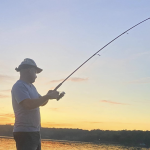 Eric Clark Jackson is a professional artist whose work explores a connection to the water and wildlife of the Chesapeake Bay. A contemporary fiber artist, his work is an intersection of fine art, contemporary craft, and the ecology of the watershed. His work has received support from the Maryland State Arts Council, Baltimore Office of Promotion and the Arts, and numerous local arts councils. He’s presented his work at the National Folk Festival, the American Craft Show and the Coconut Grove Art Fest in Miami. He is heavily involved in local watershed initiatives on the Chesapeake Bay, and he has worked with numerous non-profits on the forefront of Chesapeake Bay culture and preservation. An avid outdoorsperson, Eric continues to explore the Chesapeake from Leonardtown, where he lives with his wife and two girls.
Eric Clark Jackson is a professional artist whose work explores a connection to the water and wildlife of the Chesapeake Bay. A contemporary fiber artist, his work is an intersection of fine art, contemporary craft, and the ecology of the watershed. His work has received support from the Maryland State Arts Council, Baltimore Office of Promotion and the Arts, and numerous local arts councils. He’s presented his work at the National Folk Festival, the American Craft Show and the Coconut Grove Art Fest in Miami. He is heavily involved in local watershed initiatives on the Chesapeake Bay, and he has worked with numerous non-profits on the forefront of Chesapeake Bay culture and preservation. An avid outdoorsperson, Eric continues to explore the Chesapeake from Leonardtown, where he lives with his wife and two girls.
The post Traveling to 100 Shores with Wildlife Painter and Fiber Artist Eric Jackson | TAA Podcast Season 5, Episode 20 appeared first on How to Sell Art Online | Online Marketing for Artists.
April 24, 2023
Media & PR for Artists Case Study: Eric Jackson
Is it still possible to have a great idea for a series of new work and grow it without much of a social media presence?
Eric Jackson did it last year. With less than 1,000 followers.
Eric started selling his art at local art shows in Maryland in 2017. At the time he was teaching art in public school. After the 2020 pandemic, he left teaching to pursue his art career full time. He’d already built up some pre-pandemic momentum by scheduling up to 20 art fairs and other shows per year.
In late 2020 Eric began taking some classes with TAA. Between what he learned in classes and his own efforts, his sales steadily increased and he landed a public art project that increased his visibility.
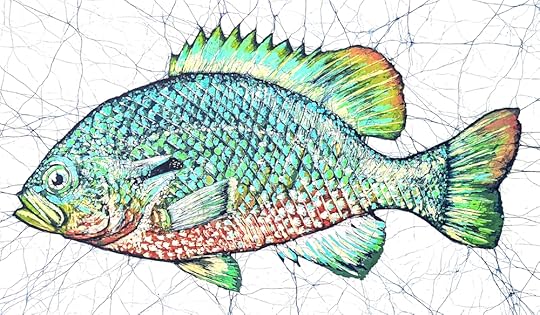
Last year he decided to build on his history of making wildlife art to make a new series about the Chesapeake Bay watershed. He wanted to bring attention to the interconnected nature of the Chesapeake Bay and the 19M+ residents who depend on the watershed. He started out by collecting water samples from 100 different sites across five states and making t-shirts using that water.
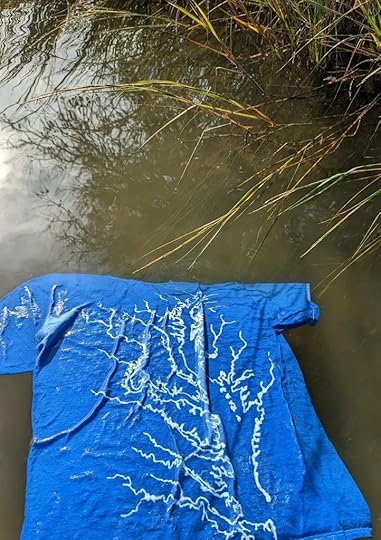
This turned into a successful Kickstarter project, relationships with a bunch of regional nature nonprofits, and his art and tshirts in various museums, art fairs, and galleries.
“ I ended up doing a press release when the project launched which brought in a ton of press last year. The first press release ended up bringing in features in five different regional papers, features in newsletters and put me in touch with tons of regional organizations which took an interest in the project. Maybe most importantly, that networked me into a bunch of contacts that I can still draw from today.“
Within a few months, he was having regular conversations with organizations interested in partnering with him, and individuals who heard about it from friends or coworkers. That word of mouth kept sales steady for the shirts throughout the year, allowing him to keep momentum going – and keep people engaged in the stories he was telling. The travel involved in the project lended itself well to long form written content describing his journey across the watershed. He crossposted interesting stories and photo journals on his blog and as regular content for his bimonthly newsletter. He noticed his open rate and click rate skyrocketing.
“I did a follow up press release when the project completed this January, and again led to a number of news features. I can probably attribute at least 1000 email signups which all came from the project and the press releases around it, and doing the press releases were absolutely a direct influence from TAA.”
Eric’s ongoing success with One Hundred Shores is due to executing the core principles of public relations work.
Knowing What to Promote – Eric knew he had something he was excited about and that might catch some interest from other people passionate about the topic of his art. Creating Solid PR materials – Eric learned how to write a concise and clear press release and assemble an effective media kit. Partnering with Influencers – once attention began rolling in, Eric was able to turn that into speaking and co-marketing opportunities.With his permission, we’ve added Eric’s initial press release to this public Google Drive folder so you can check it out. For those with experience in PR, you’ll notice it’s a pretty standard press release.
Eric isn’t rich (yet), but between original works, prints, tshirts, teaching and speaking gigs he’s on track for a very solid high five-figure year in 2023. Launching the 100 Shores Project has given his writing a focus and new things for his fans to be excited about as he rolls out new versions of the tshirts and continues to travel around the country showing his work at various art fairs.
His original works continue growing in price and recognition on the national stage. He’s shown his work at many prestigious national art festivals including Coconut Grove Art Festival, the Naples National Art Show and the American Craft Show. opening a public-facing studio in his hometown.
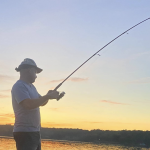
Eric Clark Jackson is a professional artist whose work explores a connection to the water and wildlife of the Chesapeake Bay. A contemporary fiber artist, his work is an intersection of fine art, contemporary craft, and the ecology of the watershed.
His work has received support from the Maryland State Arts Council, Baltimore Office of Promotion and the Arts, and numerous local arts councils. He’s presented his work at the National Folk Festival, the American Craft Show and the Coconut Grove Art Fest in Miami. He is heavily involved in local watershed initiatives on the Chesapeake Bay, and he has worked with numerous non-profits on the forefront of Chesapeake Bay culture and preservation.
An avid outdoorsperson, Eric continues to explore the Chesapeake from Leonardtown, where he lives with his wife and two girls.
The post Media & PR for Artists Case Study: Eric Jackson appeared first on How to Sell Art Online | Online Marketing for Artists.
March 30, 2023
Leaving Social Media: A Human-Centric Business Strategy with Gwenn Seemel | TAA Podcast Season 5, Episode 19
Welcome to season five, episode 19 of The Abundant Artist, the show that dispels the myth of “the starving artist” and shares how you can live an abundant life as an artist and make a living from your talent one interview at a time.
In 2016, social media platforms ruined themselves for artist Gwenn Seemel. That was the year they stole the last bit of agency from their users — replacing chronology with algorithms — and rendered themselves obsolete to her practice.
In this podcast, Gwenn talks about her decision to leave social platforms altogether; the personal, professional, and moral reasons behind her choice; and the surprising human and financial outcome of this bold stance.
“Grow those numbers, grow.…Why is it always that quantity thing? Why isn’t it the quality that we’re focusing on?” — Gwenn Seemel
Join Gwenn and Cory in a discussion on the human aspect of relationships, the collective nature of art, Capitalism as a force of destruction in the world, and a few solid tips on how to run your business away from social media, but still online and connected.
In this episode:
[:30] Cory welcomes long-time friend and artist Gwenn Seemel to ask her why she recently decided to leave social media.
[4:09] Gwenn touches on her business ROI fears without social media as well as some surprising psychological aspects of pulling away from the platforms.
[6:14] Increased emotional strength and stable income are Gwen’s current state of business despite using no social platforms.
[7:08] Standing up to Facebook’s — and most other social platforms’ — moral grayscale.
[12:11] Leaving social media: the need for resiliency and building mental health.
[15:15] Building one-on-one relationships with buyers and collectors. Gwen explains how she manages her contact list.
[22:34] Tracking inventory when your body of work has grown substantially.
[26:48] Patreon — and patronage — is not charity. Gwenn and Cory touch on the underestimated benefits of this type of platform.
[33:30] Gwen’s invaluable Patreon tips.
[36:06] When you can’t be your own “hype-man” – tips for the socially disinclined.
[38:23] Cory probes Gwenn’s thoughtfulness and the process she uses to think through questions in-depth.
[42:10] Jobs With Justice and why Gwenn cares about proper pay for anyone in any job.
[49:29] Did Capitalism lift the stark majority of the masses out of absolute poverty? Gwenn debates passionately for the dismantling of the aforementioned system!
[54:22] The German business example — welcome to the board! Cory shares his own luck as it relates to a discussion on capitalism and the state of the world.
[57:06] Why did Cory choose to go to college despite growing up in an ecosystem that didn’t foster it?
[58:56] Cory thanks Gwenn for joining the podcast!
Resources mentioned:
Gwenn Seemel’s website
All My Friends Live in My Computer: Trauma, Tactical Media, and Meaning, by Samira Rajabi
Taffy, Amanda. 2021. The Role of the Arts During COVID-19: Gendered Expressions of Resilience & Empowerment. Doctoral dissertation, Harvard T.H. Chan School of Public Health.
Artwork Archive
Jobs with Justice
The Future We Need: Organizing for a Better Democracy in the Twenty-First Century, by Erica Smiley and Sarita Gupta
About the guest: Gwenn Seemel’s polka-dot cubist painting style has been delighting art lovers and inspiring artists for twenty years — so much so that in 2017 a tech company named one of their photo filters “the Seemel.” This unusual recognition of her contribution to the look of the new millennium struck Gwenn as both a compliment and a cheeky challenge from our future AI overlords to keep making original art that matters. For Gwenn, that means joyfully feminist paintings that refuse to let us forget how interconnected we are. This work has been featured across the web, on sites like Boing Boing, Bust, Your Creative Push, Hyperallergic, and Newsweek.
Gwenn Seemel’s polka-dot cubist painting style has been delighting art lovers and inspiring artists for twenty years — so much so that in 2017 a tech company named one of their photo filters “the Seemel.” This unusual recognition of her contribution to the look of the new millennium struck Gwenn as both a compliment and a cheeky challenge from our future AI overlords to keep making original art that matters. For Gwenn, that means joyfully feminist paintings that refuse to let us forget how interconnected we are. This work has been featured across the web, on sites like Boing Boing, Bust, Your Creative Push, Hyperallergic, and Newsweek.
The post Leaving Social Media: A Human-Centric Business Strategy with Gwenn Seemel | TAA Podcast Season 5, Episode 19 appeared first on How to Sell Art Online | Online Marketing for Artists.
The Abundant Artist Goodreads blog
- Cory Huff's profile
- 31 followers


